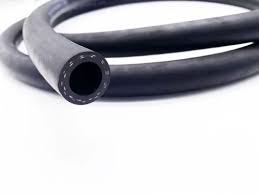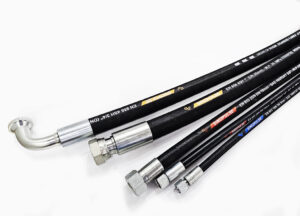
Many people want to use hydraulic hoses as the supply and return lines of fuel systems. As a professional hose manufacturer, we recommend that you do not do this directly because it is necessary to consider whether the medium transported by the hose matches the inner tube. The material of the inner tube of the hose determines its compatibility with the fluid being transported. If they are not compatible, it will cause the inner tube to age, and over time there will be problems with the hose breaking and clogging.
Next, we will explain differences between hydraulic hose and fuel hose and how to choose in this blog.
What is hydraulic hose?
Hydraulic hoses are important to hydraulic systems, used to transmit fluid power in heavy duty machines. They transport hydraulic fluid between various components. You can find them between pumps and valves, and between cylinders and motors. Hydraulic hoses are made of rubber, thermoplastic, or stainless steel.
Hydraulic hoses consist of at least three parts: an inner tube that carries the fluid, reinforcements that support the hose, and an outer cover that is abrasion- and ozone-resistant.
The difference between hydraulic hoses and fuel hoses is the inner tube material. hydraulic hoses inner tube materials is synthetic rubber, thermoplastics, or polytetrafluoroethylene. They can transport most petroleum-based and water-based hydraulic fluids. If the inner tube is incompatible with the fluid and reacts, the hose may leak or cause an accident. This is why replacement is not possible. Of course, if you are unsure about the relationship between the inner tube and the fluid being transported, please contact us and we will contact you as soon as possible.

What is fuel hose?
Fuel hoses are important parts for transporting fuel from the fuel tank to the engine. They can transport many types of fuels, such as gasoline and diesel, so they are fuel chemical compatibility and permeation resistance. Their maximum pressures are range from 30 to 100 psi. and Fuel hoses are made from many materials, including metal, rubber, braided nylon, braided steel wire, PTFE-lined, or plastic.
Rubber fuel hoses are usually confused from hydraulic hose. They are easy to install and connect with standard barbed fittings and fuel line hose clamps. They must meet specific SAE grades to ensure they meet fuel ratings and are safe for use. Two common SAE grades for fuel hoses are J30R7 and J30R9. SAE J30R7 is suitable for carburetor-rated fuel hoses, suitable for limited operation up to 50 psi. SAE J30R9 is designed for fuel injection and can withstand pressures up to 100 psi.

Hydraulic hose vs fuel hose
Fuel hose and hydraulic hose inner tubes differ in material and chemical compatibility. Fuel can react with certain rubbers (or additives). This will cause hose softening, swelling, or even brittle cracking. Therefore, fuel hoses inner tube use NBR or FKM material can be resistant to gasoline, diesel, and biofuels. Not all hydraulic hoses use this inner tube material.
Due to their different hose construction, they also have different operating pressures and safety factors. Hydraulic hoses are generally designed to withstand higher operating pressures, while fuel hoses generally have much lower operating pressures. (Although fuel injection systems may have dedicated high-pressure fuel lines, they cannot reach the same high pressures as hydraulic hoses.)
Their temperature ranges also vary depending on the application scenario. Fuel hoses must withstand the high temperatures near the engine and the rise in fuel temperature, while hydraulic hoses are designed for the high temperatures and pulsating cycles of the hydraulic system, thus having a wider temperature range.
Furthermore, due to the volatile nature of fuel, stricter requirements are placed on hose penetration and odor emission. Therefore, fuel hoses prioritize low permeability and volatility resistance. High flow rates or gasoline vapor environments can easily generate static electricity or current, so fuel lines require anti-static or shielding layers. Hydraulic hoses also have anti-static requirements in some systems, but these layers are not commonly used in general applications.
Fuel lines often use different connector standards (for example, some automotive-specific connectors). Hydraulic connectors (JIC, BSPP, etc.) are not always suitable for automotive fuel systems, resulting in differences in connector standards and installation methods.
Hose Standard
When choose fuel hose or hydraulic hoses, you need to understand hose standards. These standards specify hoses material and construction requirements , and they also set pressure resistance, temperature resistance, permeation rate, and service life. You can choose hoses that meet these standards to ensure your safety
SAE J30 fuel hose standard
The most common fuel hoses standard is SAE J30. This standard set hose classification and performance testing in gasoline, diesel, and biofuel systems. The SAE J30 fuel hose standard also includes swelling resistance testing and low permeation requirements to ensure the hose does not expand excessively or evaporate after prolonged fuel contact. This ensures maximum fuel delivery safety.
SAE J30R7 fuel line hose is the most common J30 standard hose. It's used between carburetors and tanks to transfer low-pressure fuel. It is low price to $1 per foot, so it is widely used in the automotive aftermarket. and SAE J30R9 is an improved fuel hose with lower permeation rate and higher temperature resistance than J30R7. J30r9 can handle ethanol and high-pressure fuel injection systems, further meeting current environmental and safety requirements.
Hydraulic Hose Standards
The SAE 100R series is a widely used standard for hydraulic hoses. different numbers of SAE 100R means hose types with numbers of layers and operating pressures, and correspond to different braiding or spiraling structures and pressure ratings.
ISO 18752 is an international standard that categorizes hoses by pressure range and operating conditions. This can help you select the right hydraulic hose for your specific application directly.
What are the commonly used materials for diesel hoses?
NBR (nitrile butadiene rubber), also known as Buna-N. it is a synthetic rubber with excellent resistance to petroleum-based fluids, including diesel. It also has good mechanical properties, flexible and tough, So it is ideal for transporting fuel in vehicle confined spaces. NBR fuel hoses are affordable and offer performance across a wide temperature range from -40°C to +100°C
Fluororubber (FKM). Viton brand FKM is the most well-known. This material offers excellent chemical and temperature resistance. It can withstand a wide range of corrosive chemicals and is suitable for operation in high temperature. FKM can withstand temperatures from -20°C to +200°C. Therefore, FKM can be used in more demanding applications, including exposed to harsh chemicals, high temperatures, and fluctuating repulsive forces applications. FKM is used in industrial and automotive applications, where reliability and service life are important to them. It has higher price than NBR, but its has more durability and performance in high-risk environments.
Can hydraulic hoses be interchangeable with fuel hoses?
Although both hydraulic hoses and fuel hoses are used to transport fluids. For your safety, it's not recommended to use hydraulic hoses as fuel hoses. Because the hydraulic hose inner tube is designed for transporting hydraulic fluids (mineral or synthetic), and fuel can react chemically with some rubber or synthetic materials. Unless your hydraulic hose manufacturer's data sheet says that fuel compatibility or hose is meet fuel hose standard such as SAE J30. And replacing fuel hoses to ordinary hydraulic hoses could cause fuel corrosion, leading to leaks or blockages for a long time.
Therefore, hydraulic hoses and fuel hoses are not interchangeable. Certain hydraulic hoses (mostly diesel hoses) can only be replaced as fuel hoses after marked and certified.
How to choose fuel hose
When choosing a fuel hose, you must consider hose safety and durability. Modern fuels contain additives. They may react traditional rubber hoses (including stainless steel braided hoses), making them harden and deteriorate and potentially leading to leaks and seepage. Once fuel lines age, rubber hoses particles can contaminate and clog injector and carburetor hoses, affecting performance and causing a variety of problems. Therefore, choosing the right fuel hose is crucial.
Before choose a fuel hose, you need to understand the type of fuel your car use—diesel, gasoline, or another fuel like ethane. Biodiesel blends or high aromatic content fuels may need a specific hose material with greater compatibility, like FKM.
you should also consult the engine manual or equipment specifications to learn pressure requirements and understand the operating pressure of the fuel system. Ensure that fuel hose meets or exceeds the system's pressure rating.
The fuel hose material should also be based on the engine's operating temperature range. Nitrile rubber may degrade in extreme temperatures. Next, consider whether you need an anti-static or shielding layer in your specific application. As we all know, safety is most important when handling fuel systems. Choose hoses that meet industry standards, such as SAE J30R (for J30R6/R7 diesel fuel lines and diesel return lines) or ISO 4217 (for J30R9 fuel injection and delivery hoses). These standards ensure that the hoses meet specific performance. If you're still struggling wich fuel hose to choose, feel free to consult sinopulse hydraulic or fuel hose expert.
Fuel hose install and maintain
First, to install fuel hose tightly, you need to select the correct fuel hose and connectors, tighten them with appropriate force to ensure a tight seal.
Regularly inspect the hose to ensure proper fuel system operation. Check for swelling on the inner wall, leaks, and cracks and signs of wear on the outer layer.
As a professional fuel hose manufacturer, we recommend that you replace your fuel hose regularly to ensure the proper operation of your vehicle.
FAQ
What is diesel
Diesel is a liquid fuel. It has many compositions, including alkanes, cycloalkanes, and aromatics. It is used in compression-ignition diesel engines. It is a hydrocarbon-derived complex mixture from the distillation of crude oil. Unlike spark-ignition engines gasoline, diesel have a higher boiling point and higher viscosity. This let it has a slower, more controlled combustion process, making it suitable for heavy-duty applications.
Can I use a hydraulic hose to transport diesel fuel?
Generally speaking, yes. but if you choose hydraulic hoses for diesel fuel, you should refer to the hydraulic hose manufacturer's specifications and ask them supply industry standard documentation that hoses could transport compatibility with petroleum-based fluids. However, we also advise you to use diesel-grade hydraulic hoses, because they are designed and manufactured for diesel fuel. These hoses are made of nitrile rubber (NBR) or fluororubber (FKM) materials which are compatible with the chemical composition of diesel fuel and its additives. This would be better for your safety use.
Can hydraulic hoses be used for gasoline?
No, no professor recommends using hydraulic hoses with gasoline. because gasoline's additives and chemicals can damage the hydraulic hoses inner synthetic rubber tube
This would make the hose material to chemically decompose, swell, or soften, damage the hose, and potentially lead to hose leaks or failure. Furthermore, gasoline is highly flammable. Once the gasoline leaks, it will endanger your safety.
So gasoline, you should use fuel hoses designed and rated for gasoline . These hoses have withstood the chemical materials. Ensure your safety.
When should fuel hoses be replaced?
Fuel hoses wear out and must be inspected and replaced regularly. Fuel lines should be replaced every five years. Of course, your car might be 30 years old and you've never replaced the lines, but that's not a good idea. Even within fuel lines, the fuel itself can corrode the hoses. This can cause small particles to lodge in the fuel and become lodged in the filter, carburetor, or fuel injection system. Eventually, the hoses will rupture.
Browse our selection of wholesale hydraulic hoses and fuel hoses. We offer a wide range of fuel hoses with optimal performance and long-term reliability. Contact us today for a quote and contact our experienced hydraulic hose team for your needs.

